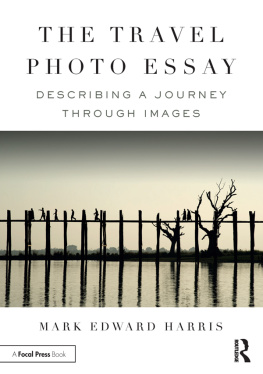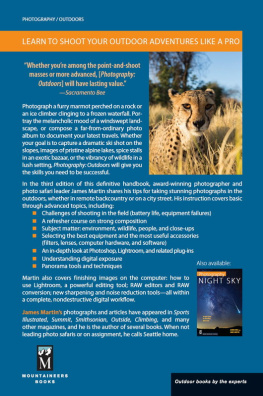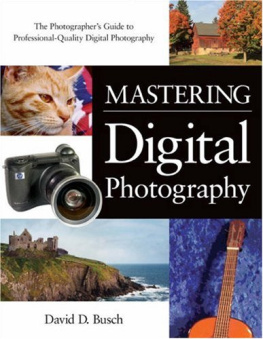Follow the Sun
Follow the Sun will guide you through all aspects of architectural photography, from the genres rich history to the exciting new approaches brought by the advent of the digital age. It explains how to use the powerful tools of digital photography while employing many of the skills and traditions of the established genre. Written to be accessible to professionals, amateurs, and students alike, this book will be useful for photographers exploring architecture as fine artists, on editorial assignments, or on commercial shoots.
Key features include:
- Example photographs and diagrams
- Historical background of architectural photography
- Advice on essential equipment
- How to plan a shoot to your advantage
- How to use tilt-shift lenses for architecture
- Editing workflow and strategies
- Interviews with architectural photographers Peter Aaron, Magda Biernat, Ty Cole, and Elizabeth Felicella.
James Ewing is an award-winning photographer of architecture, landscapes, and interiors. His work has been featured in publications such as Architect, Architectural Record, Metropolis, Architectural Digest, Wallpaper, Icon, Azure, Surface, lArchitecture dAujourdhui, A+U , and The New York Times , among others. James is the recipient of the 2010 and 2014 American Photographic Artists (APA) top prize for Architectural Photography. He has taught photography at CUNY Kingsborough Community College, Oakland Community College, and Indiana University School of Fine Arts. He lives in Brooklyn, New York.
Follow the Sun
A Field Guide to Architectural Photography in the Digital Age
James Ewing
First published 2017
by Routledge
711 Third Avenue, New York, NY 10017
and by Routledge
2 Park Square, Milton Park, Abingdon, Oxon OX14 4RN
Routledge is an imprint of the Taylor & Francis Group, an informa business
2017 Taylor & Francis
The right of James Ewing to be identified as author of this work has been asserted by him in accordance with sections 77 and 78 of the Copyright, Designs and Patents Act 1988.
All rights reserved. No part of this book may be reprinted or reproduced or utilised in any form or by any electronic, mechanical, or other means, now known or hereafter invented, including photocopying and recording, or in any information storage or retrieval system, without permission in writing from the publishers.
Trademark notice: Product or corporate names may be trademarks or registered trademarks, and are used only for identification and explanation without intent to infringe.
Library of Congress Cataloging in Publication Data
Names: Ewing, James (Photographer)
Title: Follow the sun : a field guide to architectural photography in the
digital age / by James Ewing.
Description: New York : Routledge, 2016. | Includes bibliographical
references and index.
Identifiers: LCCN 2015045001 (print) | LCCN 2016000823 (ebook) |
ISBN 9780415747004 (hardback : alk. paper) | ISBN 9780415747011
(pbk. : alk. paper) | ISBN 9781315797281 (ebook) | ISBN
9781315797281 ( )
Subjects: LCSH: Architectural photographyHandbooks, manuals, etc.
| PhotographyDigital techniquesHandbooks, manuals, etc.
Classification: LCC TR659 .E88 2016 (print) | LCC TR659 (ebook) |
DDC 778.9/4dc23
LC record available at http://lccn.loc.gov/2015045001
ISBN: 978-0-415-74700-4 (hbk)
ISBN: 978-0-415-74701-1 (pbk)
ISBN: 978-1-315-79728-1 (ebk)
Typeset in Minion Pro and Avenir
by Florence Production Ltd, Stoodleigh, Devon, UK
Contents
Sincere thanks to my mentors, peers, and friends: Michael Moran, Nicholas Knight, Peter Aaron and Elizabeth Felicella. With special gratitude to the consistent encouragement, support and love from my wife, Sarah Butler, without whom this book would not exist.
Part 1
Background
Chapter 1
What is Architectural Photography?
Architectural photographs are illustrations of buildings and interiors. Like all images they carry the agenda, style, and voice of their creators.
Unless you live in the same neighborhood as a building you are most likely to experience it only through images. Photographs bring architecture to an audiencethey are used to educate, inform, inspire, preserve, and sell the work of the designers and architects. The photographer as author of these images is a crucial participant in the design process.
First and foremost architects and interior designers need images. The architects legacy and continued success depends on a portfolio of exceptional images which illustrate the quality of their work. Architects use photography to submit for awards, to show their work to potential new clients, and to promote their brand in the design media. It is critical for an architect working today to have a website that highlights their work with images. As an architects career progresses they will publish monographs which will also depend on a large body of excellent images.
Design media such as architecture magazines and websites need images. The images are just as important as the text in an architecural review of a building. When we read an architecture magazine or blog it is usually the images that stay with us and leave the most lasting impression of the building. Without great images design magazines would not exist.
Everyone involved in the building tradesfrom engineering firms, to vendors, to furniture companiesneeds images to promote their work. The hospitality and real-estate industries need exceptional architectural images to sell luxury interiors and homes to a discerning clientele.

Lige-Guillemins railway station designed by Santiago Calatrava, opened in 2009.

James River House, Scottsville, Virginia designed by Architecture Firm.
Education needs images. Architecture students learn the history of architecture through slide lectures and illustrated books. These slide lectures depend on images of architecture to describe the buildings and sites of architectural history. Monographs of historic architectural movements rely on images to illustrate the importance of a particular era or movement in design.
Posterity needs images. The images photographers make today of buildings and cities will be used 100 years from now to illustrate how these places once appeared. Buildings and interiors change over time. Cities are in constant flux. Changes that happen on a daily basis may not be obviously apparent to us but when we look at images from 50 or 100 years ago we see glimpses of an entirely different world.
The fine art world needs images. It is not unusual in architectural photography for the images created as a commercial commission to later become categorized as artworks in their own right. Ezra Stoller was commissioned by architects to illustrate buildings in the 1950s, 1960s, and 1970s. Today his highly valued prints are sold at art galleries and exhibited in art museums. Architectural photography is one way to explore the meaning of our environments. Many of todays most successful artistsThomas Struth, Hiroshi Sugimoto, and Andreas Gursky to name but a feware working in the genre of architectural photography.










